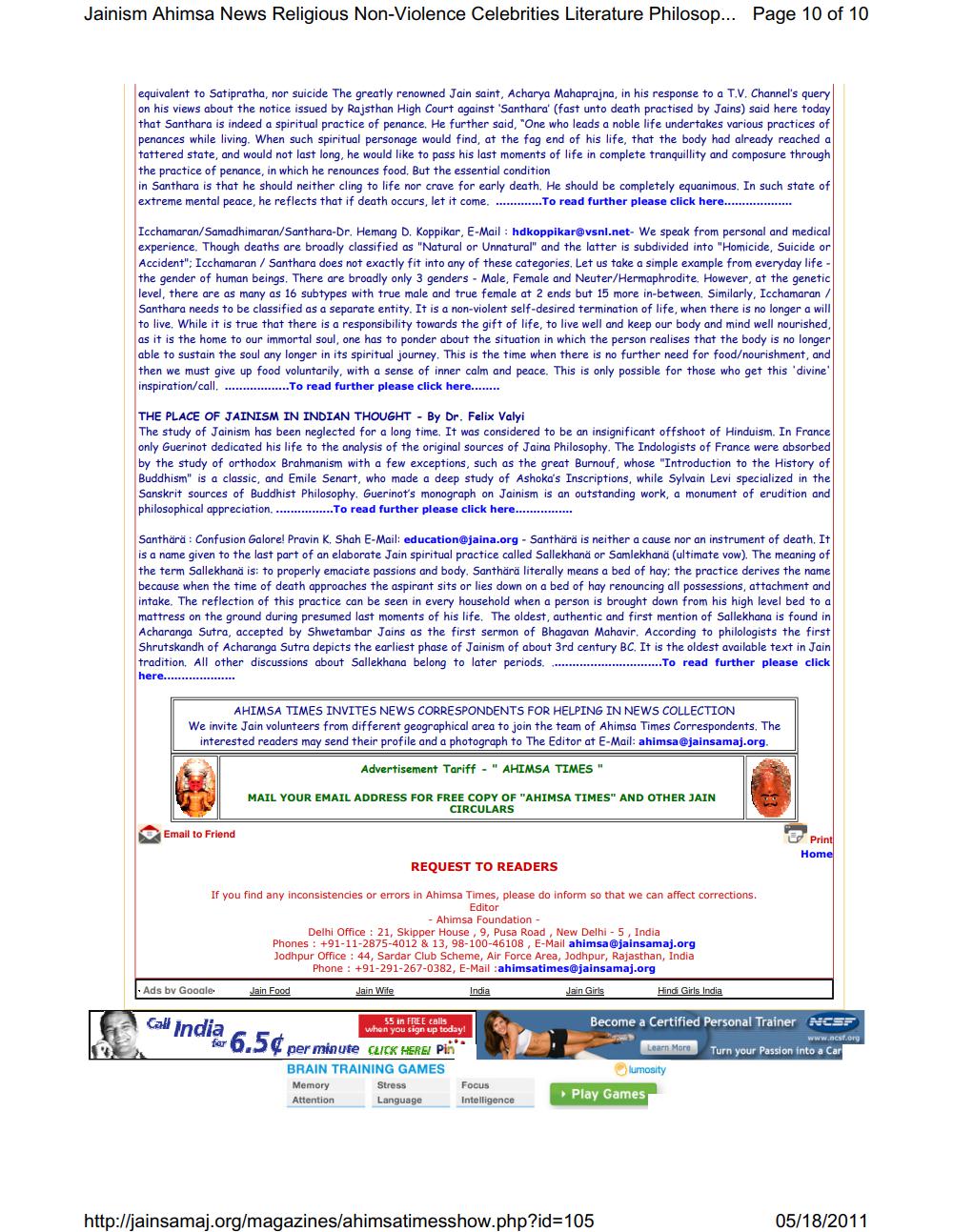________________ Jainism Ahimsa News Religious Non-Violence Celebrities Literature Philosop... Page 10 of 10 equivalent to Satipratha, nor suicide The greatly renowned Jain saint, Acharya Mahaprajna, in his response to a T.V. Channel's query on his views about the notice issued by Rajsthan High Court against 'Santhara' (fast unto death practised by Jains) said here today that Santhara is indeed a spiritual practice of penance. He further said, "One who leads a noble life undertakes various practices of penances while living. When such spiritual personage would find, at the fag end of his life, that the body had already reached a tattered state, and would not last long, he would like to pass his last moments of life in complete tranquillity and composure through the practice of penance, in which he renounces food. But the essential condition in Santhara is that he should neither cling to life nor crave for early death. He should be completely equanimous. In such state of extreme mental peace, he reflects that if death occurs, let it come. ............. To read further please click here Icchamaran/Samadhimaran/Santhara-Dr. Hemang D. Koppikar, E-Mail :
[email protected] We speak from personal and medical experience. Though deaths are broadly classified as "Natural or Unnatural" and the latter is subdivided into "Homicide, Suicide or Accident": Icchamaran / Santhara does not exactly fit into any of these categories. Let us take a simple example from everyday life - the gender of human beings. There are broadly only 3 genders - Male, Female and Neuter/Hermaphrodite. However, at the genetic level, there are as many as 16 subtypes with true male and true female at 2 ends but 15 more in-between. Similarly, Icchamaran / Santhara needs to be classified as a separate entity. It is a non-violent self-desired termination of life, when there is no longer a will to live. While it is true that there is a responsibility towards the gift of life, to live well and keep our body and mind well nourished, as it is the home to our immortal soul, one has to ponder about the situation in which the person realises that the body is no longer able to sustain the soul any longer in its spiritual journey. This is the time when there is no further need for food/nourishment, and then we must give up food voluntarily, with a sense of inner calm and peace. This is only possible for those who get this 'divine inspiration/call. ... ..........To read further please click here........ THE PLACE OF JAINISM IN INDIAN THOUGHT - By Dr. Felix Valyi The study of Jainism has been neglected for a long time. It was considered to be an insignificant offshoot of Hinduism. In France only Guerinot dedicated his life to the analysis of the original sources of Jaina Philosophy. The Indologists of France were absorbed by the study of orthodox Brahmanism with a few exceptions, such as the great Burnouf, whose "Introduction to the History of Buddhism" is a classic, and Emile Senart, who made a deep study of Ashoka's Inscriptions, while Sylvain Levi specialized in the Sanskrit sources of Buddhist Philosophy. Guerinot's monograph on Jainism is an outstanding work, a monument of erudition and philosophical appreciation. ................. To read further please click here.............. Santhara : Confusion Galore! Pravin K. Shah E-Mail:
[email protected] - Santhara is neither a cause nor an instrument of death. It is a name given to the last part of an elaborate Jain spiritual practice called Sallekhana or Samlekhana (ultimate vow). The meaning of the term Sallekhana is: to properly emaciate passions and body. Santhara literally means a bed of hay; the practice derives the name because when the time of death approaches the aspirant sits or lies down on a bed of hay renouncing all possessions, attachment and intake. The reflection of this practice can be seen in every household when a person is brought down from his high level bed to a mattress on the ground during presumed last moments of his life. The oldest, authentic and first mention of Sallekhana is found in Acharanga Sutra, accepted by Shwetambar Jains as the first sermon of Bhagavan Mahavir. According to philologists the first Shrutskandh of Acharanga Sutra depicts the earliest phase of Jainism of about 3rd century BC. It is the oldest available text in Jain tradition. All other discussions about Sallekhana belong to later periods. ...... ..... To read further please click here. AHIMSA TIMES INVITES NEWS CORRESPONDENTS FOR HELPING IN NEWS COLLECTION We invite Jain volunteers from different geographical area to join the team of Ahimsa Times Correspondents. The interested readers may send their profile and a photograph to The Editor at E-Mail:
[email protected]. Advertisement Tariff - " AHIMSA TIMES" MAIL YOUR EMAIL ADDRESS FOR FREE COPY OF "AHIMSA TIMES" AND OTHER JAIN CIRCULARS Email to Friend Ed Print Home REQUEST TO READERS If you find any inconsistencies or errors in Ahimsa Times, please do inform so that we can affect corrections. Editor - Ahimsa Foundation - Delhi Office : 21, Skipper House , 9, Pusa Road, New Delhi - 5 , India Phones : +91-11-2875-4012 & 13, 98-100-46108, E-Mail
[email protected] Jodhpur Office : 44, Sardar Club Scheme, Air Force Area, Jodhpur, Rajasthan, India Phone : +91-291-267-0382, E-Mail :
[email protected] * Ads by Google, Jain Food Jain Wife India Jain Girls Hindi Girls India Hocam Indor 6.5EUR per minute CLICK $5 in FREE calls when you sign up today! Become a Certified Personal Trainer NCSF www.ncsf.org Learn More Learn More Turn your Passion into a Car TOF per minute CLICK HERE! Pi. BRAIN TRAINING GAMES Memory Stress Attention Language Focus Intelligence lumosity Play Games http://jainsamaj.org/magazines/ahimsatimesshow.php?id=105 05/18/2011
